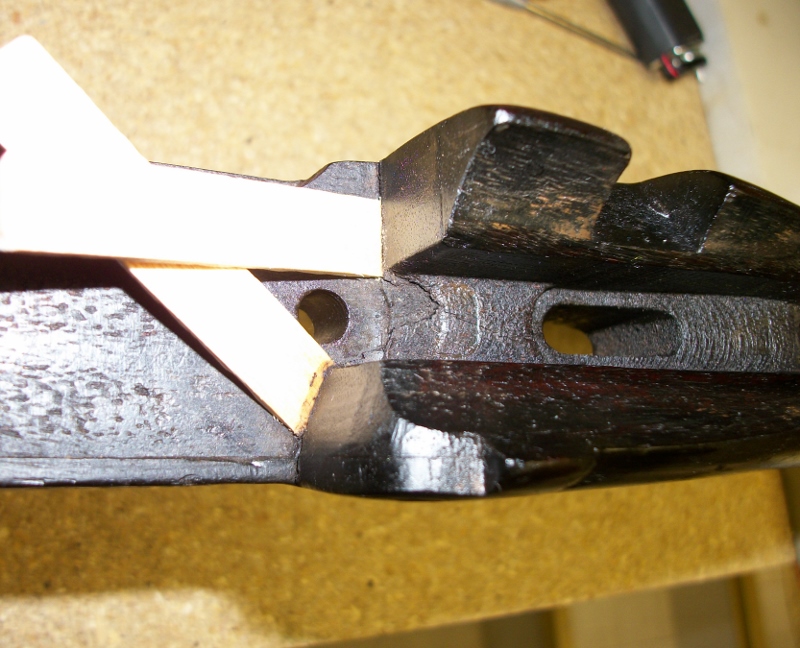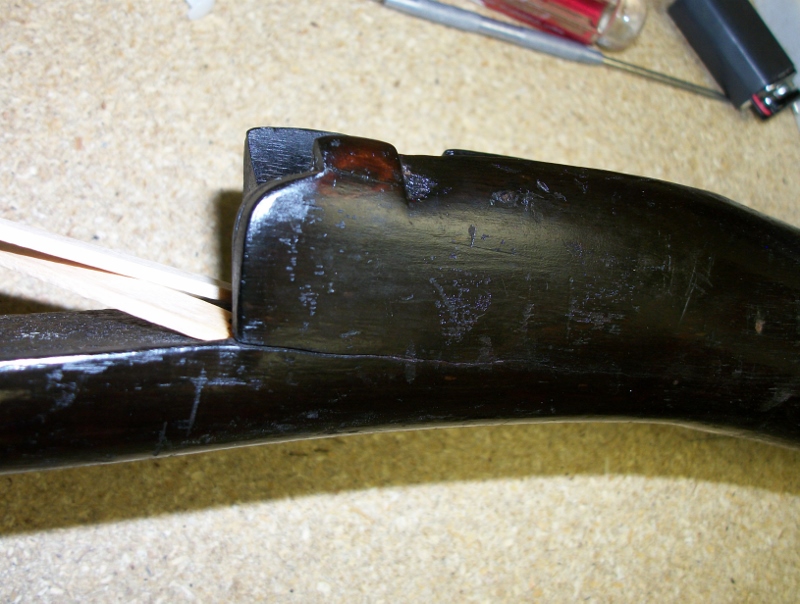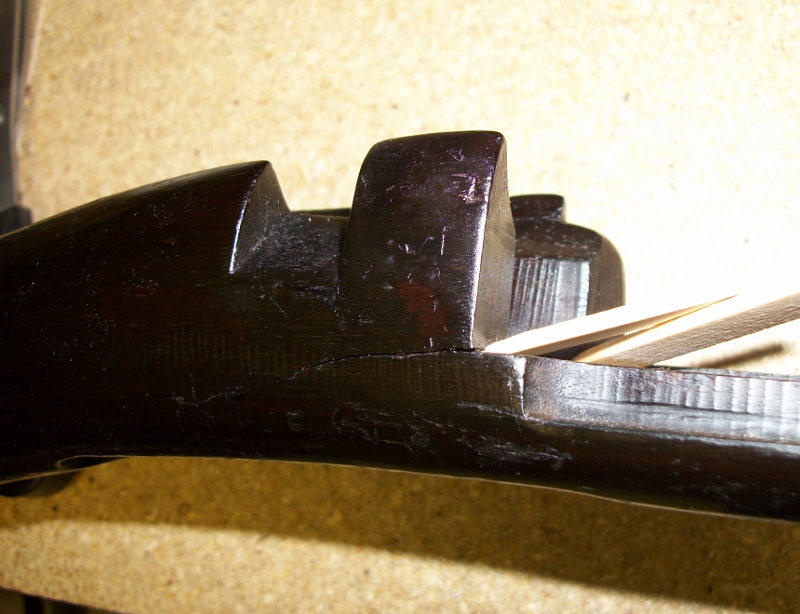Cracked Stock
- psteinmayer
- Posts: 2690
- Joined: Tue Aug 30, 2011 2:31 am
Re: Cracked Stock
I'm not going to do anything that will alter the bedding areas. I'm sure that my fix will work great, and all will be well.
- psteinmayer
- Posts: 2690
- Joined: Tue Aug 30, 2011 2:31 am
Re: Cracked Stock
Ok... I've made a couple small wooden wedges to hold the crack open. The most I could get the crack opened is to approximately 0.02 in., so I'm glad it's not too bad. I used an insulin syringe to inject acetone into the cracked areas, and used compressed air (from a computer cleaning can) to aid in the drying. I'm going to allow it to sit for 24 hours, and then repeat this.
I'm then going to carefully drill a small hole (about 0.1 in.) on each side of the stock from the magazine well rearward along the crack about 1/4 inch from the sides of the stock and 1 in. long. This will allow me to be able to inject epoxy into the cracked area which should spread throughout the crack. I'll clamp it and let it cure for a while.
After the epoxy cures for a few days, I'm going to drill two holes - between the trigger slot and each trigger guard screw, and epoxy a hard wood dowel in each hole, which should provide added strength to the repair. The dowels will be carefully measured so as to not touch the action in any way, so I don't violate any CMP rules.
I'll photo-document the entire repair and share with everyone as I go.
I'm then going to carefully drill a small hole (about 0.1 in.) on each side of the stock from the magazine well rearward along the crack about 1/4 inch from the sides of the stock and 1 in. long. This will allow me to be able to inject epoxy into the cracked area which should spread throughout the crack. I'll clamp it and let it cure for a while.
After the epoxy cures for a few days, I'm going to drill two holes - between the trigger slot and each trigger guard screw, and epoxy a hard wood dowel in each hole, which should provide added strength to the repair. The dowels will be carefully measured so as to not touch the action in any way, so I don't violate any CMP rules.
I'll photo-document the entire repair and share with everyone as I go.
- Parashooter
- Posts: 707
- Joined: Thu Feb 04, 2010 5:14 am
- Location: Kragmudgeon House, CT
Re: Cracked Stock
. . . I'm going to drill two holes - between the trigger slot and each trigger guard screw, and epoxy a hard wood dowel in each hole, which should provide added strength to the repair. . .
If I'm understanding correctly, it seems the dowels won't do anything useful that isn't already being done by the two sturdy steel screws clamping the triggerguard over that area - and the added holes could be a source of weakness if the glue fails on the dowels.
Cracks of this sort happen because the stock "hinges" at its weakest point - below the magazine and forward of the triggerguard. Good glue coverage in the cleaned crack should be enough. (If you can clean the crack thoroughly, that "good old yellow wood glue" might be better than epoxy - if only because it will penetrate better and doesn't creep after setting.)
- psteinmayer
- Posts: 2690
- Joined: Tue Aug 30, 2011 2:31 am
Re: Cracked Stock
You might be right about that. I was just thinking of some added lateral strength. I'm not set on that part of it. I think the rest of my repair plan is good though. Where is everyone on the wood glue vs two-part epoxy? I'm just concerned about wood glue where the stock might eventually get wet (like if it's raining)... or if I can't get the oil dried out of the entire crack. Obviously, I'm concerned and want this repair to be as strong as possible.
Re: Cracked Stock
When in doubt, use epoxy. Yellow glue is ok, but the integrity of the joint depends on coating both surfaces thoroughly. Since you have very narrow confines in which to spread the glue around following those protocols would be problematic. Just get the epoxy in there and close and open the joint a few times to squeeze it around and about in there. Yellow glue also requires more clamping pressure for a good bond than is necessary with epoxy- something to take into consideration given the nature of the object of art you're dealing with. :)
I commented about the need for auxiliary dowels in your other thread. Basically, a well put together epoxy joint (such as you appear to be achieving) will be stronger than the surrounding wood, obviating the need for mechanical support.
I commented about the need for auxiliary dowels in your other thread. Basically, a well put together epoxy joint (such as you appear to be achieving) will be stronger than the surrounding wood, obviating the need for mechanical support.
- psteinmayer
- Posts: 2690
- Joined: Tue Aug 30, 2011 2:31 am
Re: Cracked Stock
I'm going to dispense with the lateral dowels and just go with my planned epoxy repair.
I went to a wood working store today and picked up some structural epoxy today with a 30-45 minute set time, and 36 hour cure. Also, on the advice of the people there, I will use denatured alcohol to clean out the crack. It evaporates very quickly, and will clean the wood. I was told that the acetone contains a small amount of oil, which could prevent it from cleaning all of the oil from the wood. Attached are a few pictures with the crack opened as wide as I can without damaging it further. As you can see, it's not very wide.



I went to a wood working store today and picked up some structural epoxy today with a 30-45 minute set time, and 36 hour cure. Also, on the advice of the people there, I will use denatured alcohol to clean out the crack. It evaporates very quickly, and will clean the wood. I was told that the acetone contains a small amount of oil, which could prevent it from cleaning all of the oil from the wood. Attached are a few pictures with the crack opened as wide as I can without damaging it further. As you can see, it's not very wide.



Re: Cracked Stock
I don't see how you could possibly get enough epoxy to flow into the cracks to make an effective repair. Rules or not, I'd opt for routing some of the crack out. As far as cleaining is concerned, the linseed penetrates a surprisingly small amount of the stock (maybe 1/16 of an inch). I wouldn't even bother cleaning it out.
Re: Cracked Stock
Epoxy only needs a couple of molecules of thickness to effect a bond. Plenty enough can be worked into that crack.
As for acetone containing trace amounts of oil, if it does it's such a small amount as to be totally inconsequential. We use it to de-oil teak before gluing up, I use it as my primary de-greaser when prepping for rust bluing and you know how spotlessly oil free steel must be for that. Acetone evaporates as readily as alcohol, and ishands down better in this situation. We use alcohol routinely as a cleanup solvent for epoxy glue-ups, never as a surface prep.
Not meaning to sound strident, but 20 years building wooden boats from dinghys to 40 foot sail boats, using epoxy, has taught me a thing or two.
Obviously Mr. Steinmeyer has the situation well in hand. No doubt that Krag will be singing its sweet song again in no time!
As for acetone containing trace amounts of oil, if it does it's such a small amount as to be totally inconsequential. We use it to de-oil teak before gluing up, I use it as my primary de-greaser when prepping for rust bluing and you know how spotlessly oil free steel must be for that. Acetone evaporates as readily as alcohol, and ishands down better in this situation. We use alcohol routinely as a cleanup solvent for epoxy glue-ups, never as a surface prep.
Not meaning to sound strident, but 20 years building wooden boats from dinghys to 40 foot sail boats, using epoxy, has taught me a thing or two.
Obviously Mr. Steinmeyer has the situation well in hand. No doubt that Krag will be singing its sweet song again in no time!
Re: Cracked Stock
The crack appears to be a maximum of .020" wide, when it is wedged open. The clearance is less as you move aft on the stock. I believe the epoxy would not flow down into the crack with this small clearance. Hence, the need to route out part of the crack (to get the epoxy to flow into the void). Clamp and squeeze the crack all you want, but, first, you have to get the epoxy in there.
Not to brag, but after 54 year of building, refinishing, repairing and bedding gun stocks, I believe I know a few things about stock repair.
Not to brag, but after 54 year of building, refinishing, repairing and bedding gun stocks, I believe I know a few things about stock repair.
- psteinmayer
- Posts: 2690
- Joined: Tue Aug 30, 2011 2:31 am
Re: Cracked Stock
I'm going to use the acetone again... at least two more times to make sure there are no traces of oil left in that crack.
In response to cdagnese, I'm going to drill two small holes running along the crack and parallel to the sides of the stock about 3/16 from the sides, and running for at least an inch and a half. These holes (0.1 dia) will provide me with an area to inject the epoxy, which should flow outward from there into all areas of the crack. With a 30+ minute working time, if I see epoxy oozing from the crack when I clamp the stock, I'll know I've achieved my goal. If not, I'll have sufficient time to inject more until I do. I'm going to use an epoxy injector for this, and for the really tight areas, a syringe with a very small needle (insulin syringe - about a 30 gauge needle).
In response to cdagnese, I'm going to drill two small holes running along the crack and parallel to the sides of the stock about 3/16 from the sides, and running for at least an inch and a half. These holes (0.1 dia) will provide me with an area to inject the epoxy, which should flow outward from there into all areas of the crack. With a 30+ minute working time, if I see epoxy oozing from the crack when I clamp the stock, I'll know I've achieved my goal. If not, I'll have sufficient time to inject more until I do. I'm going to use an epoxy injector for this, and for the really tight areas, a syringe with a very small needle (insulin syringe - about a 30 gauge needle).
